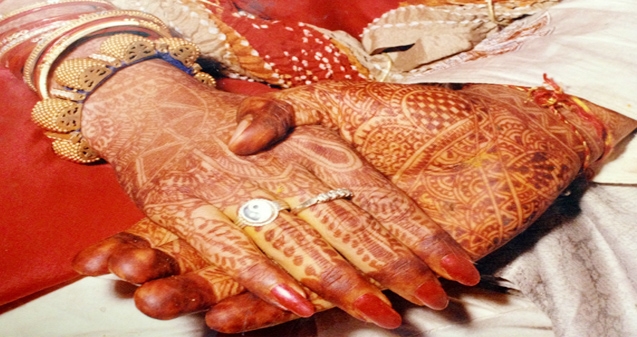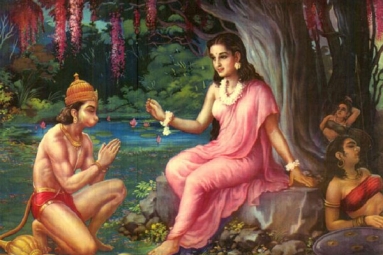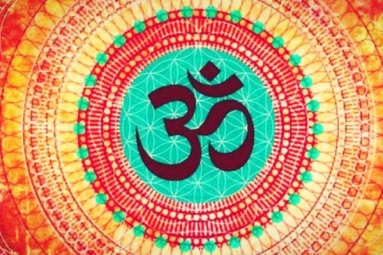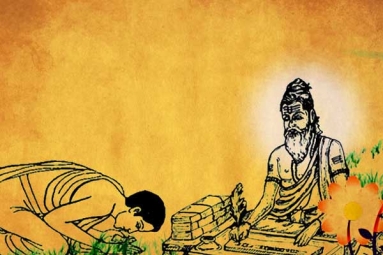
A Telugu marriage has ceremonies, rites and rituals that are full of symbolism and rich significance. These are performed like most Hindu marriage rites with an emphasis on spirituality. The wife has a prestigious place in all ceremonies. She is the ardhangini, a part of her husband, literally meaning 'half of the body'. No religious ritual can be performed by her husband in her absence. The rites are conducted by a purohit or priest. The marriage usually takes place in any month with the exception of the months of Aashad, Bhadrapad and Shunya, which are considered inauspicious for weddings.
Muhurtam
This involves determining the auspicious part of the day for the marriage. The period that is considered auspicious starts from 7.00 p.m. and goes on till the next day until about 11 am. Weddings don't usually take place in the months of Aashad, Bhadrapad and Shunya.
Pendlikoothuru
This ceremony involves anointing the bride and the groom with oil and turmeric. This is followed by a bath. The couple don new clothes following the bath. The bride-to-be wears flowers in her hair. She adorns her forehead with a bindi or vermillion dot and wears bangles on her wrists.
Snathakam
This ritual is performed at the bridegroom's house before the muhurtam. It is a sort of thread ceremony that involves making him wear a silver thread on his body.
Kashi Yatra
After the recitation of Vedic verses, the groom pretends to leave for Kashi, a pilgrimage centre to devote himself to God and a life of prayer. He carries a walking stick and other spartan essentials with him and implies that he is not interested in becoming a householder anymore. He relents and agrees to the marriage only after he is stopped and persuaded by the bride's brother to fulfill his responsibilities as a householder.
Mangala Snaanam
The bride and groom must take a Mangala Snaanam or an auspicious bath on the day of the wedding. The bath is believed to cleanse and purify them and make them ready for the sacred rites that are to follow.
Aarti
After the bath, the bride and groom are anointed with oil at their respective homes. Their families perform aarti - a ceremony that involves placing a lit oil lamp or diya on a plate and circling the plate around a person in a clockwise direction. The clockwise movement is followed to imitate the earth's movement round the sun. The ceremony is significant as it carries with it the family's prayer that the mind of the bride/groom be illuminated by wisdom.
Gauri Pooja
The bride worships the Goddess Gauri by performing Gauri Pooja. The Goddess Gauri is highly revered as it is believed that she is a manifestation of Shakti, the mother of the universe and the power and energy by which God creates, preserves and destroys the world. She symbolises motherhood, fertility and the victory of good over evil.
Ganesh Pooja
The bridegroom performs Ganesh Pooja in the mandapam or wedding hall just before the marriage ceremony. Worshipping Ganesha, the elephant-headed God is an important part of most Hindu rituals as he is revered as the remover of all obstacles.
WEDDING RITUALS
Kanyadaan
The Kanayadaan is that part of the marriage ceremony in which the girl's family gives her away to the groom. Her maternal uncle carries the bride-to-be in a bamboo basket to the mandapam. The bride and bridegroom are separated by a curtain placed between them. They are not to see each other until after the marriage ceremony. The priest invokes the blessings of the ancestors belonging to the last seven generations of both families. The bride's parents wash the groom's feet in a gesture that symbolises their belief that he is a form of God to whom they now offer their daughter's hand.
Jeerakalla-Bellamu
After the priest recites the wedding shlokas from the Vedas, the bride and groom apply a paste of cumin seeds (jeera) and jaggery on each other's hands. This is known as Jeelakarra-Bellamu. The slightly bitter cumin and sweet jaggery when ground together turn into an inseparable mixture. Communicating that the bride and groom are supposed to become inseparable through life's bitter and sweet times. .
Madhuparkam
For the Madhuparkam, the bride wears a white cotton sari with a red border, while the groom dons a white cotton dhoti, also with a red border. White signifies purity and chastity, while red is a colour that represents strength.
Sumangli
The girl is accompanied by ten married women (Sumangalis). Six of them hold plates full of rice and turmeric powder mixed together. The remaining hold plates with small lamps made from a mixture of rice flour, sugar and milk. Rice, the staple crop of the south, signifies abundance. The lit lamps represent sweetness and light, two qualities that the bride brings with her to this new phase of life.
Tying of the Mangalsutra
The curtain between the two is removed at this stage. Prayers offered, the groom ties the two strings (each with a golden disc representing the mangalsutra) separately around the girls neck, with three knots to represent the strength of their union on every plane - physical, mental and spiritual. The groom holds the bride's hand and gazes at the pole star or Dhruva (represents constancy) with her. The couple also look towards the stars Vasishta and Arundhati (part of the Great Bear Constellation, known as Sapta Rishi or Seven Sages). These stars, always visible together, have come to symbolise an inseparable couple.
Kanyadaan Akshata
Having tied the mangalsutra, the couple now exchange garlands. Those present at the wedding shower their blessings on the couple by sprinkling flowers and turmeric-coloured rice (Akshata) on them.
Saptapadi
'Saptapadi' or seven steps are what the couple takes together. During this, the bride's saree and the groom's dhoti are tied together at one end in a knot. The groom prays for life-long blessings with each step - with the first step he prays for food that nourishes them, with the second step he prays for strength, with the third for help in honouring their vows, with the fourth for a comfortable life, with the fifth for the health of their cattle, with the sixth for a life that survives the seasons, and with the seventh for help in fulfilling religious duties. During this ceremony, saris, ornaments and other gifts are offered to the couple and to other family members.
Sthaalipaakam
The groom slips silver toe rings on the bride's feet. The girl is also adorned with a string of b.
POST-WEDDING RITUALS
Grihapravesh
The marriage ceremony over, the bride is taken to the groom's home for Griha Pravesh (entering the house for the first time).
Uniting the mangalsutra
The two mangalsutras are united on a common thread 16 days after the wedding. An elder member of the family or the husband himself can unite the two mangalsutras on a common thread. A few black or golden beads are slipped between the two plates so that they don't clash with each other. Signifying harmony between the two families. The bride takes a bath and wears a new sari before wearing the mangalsutra on this day. The number 16 is a very auspicious number among Hindus. Also, 16 days are symbolic of the time needed by the bride to understand her husband's family.
source : shubhlagan








